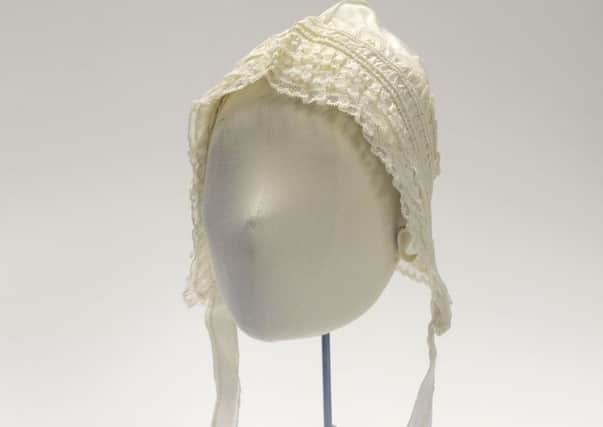Exhibit of the Week: Simple bonnet was worn on a daily basis


This pretty and very simple muslin cap decorated with pin tucks, handmade lace, and ties under the chin, dates from the early to mid Victorian period, and would have been worn by an adult. It would have been worn alone, as you see it here, indoors on a daily basis and under a black satin Sunday bonnet on high days and holidays
It probably wouldn’t, though, qualify as an Easter bonnet – wrong period, wrong country (these days, anyway), and just not fancy enough.
Advertisement
Hide AdAdvertisement
Hide AdThe Easter bonnet is usually a pretty decorative affair, and is one of the last vestiges of the tradition of wearing new clothes for the season – a representation of spiritual renewal and redemption; a sort of sartorial spring cleaning.
The tradition of getting new clothes to mark the coming of spring dates back centuries – an old adage has it that: ‘At Easter let your clothes be new, or else be sure you will it rue’.
And in Romeo and Juliet, believed to have been written in the 1590s, Shakespeare has Romeo’s cousin Benvolio donning a new suit before Easter and Mercutio reminding him of his crime: “Didst thou not fall out with a tailor for wearing his new doublet before Easter?”
Nowadays though, the tradition of the Easter bonnet has evolved into something associated more with the States than with this country and as so often happens, it’s because of a hugely popular piece of popular culture originating in America.
Advertisement
Hide AdAdvertisement
Hide AdNew York’s Easter Parade and Easter Bonnet Festival has been a city tradition for over 100 years. Taking place each year on Easter Sunday, ‘paraders’ promenade in outrageous and spectacular costumes, ranging from the historical to the fantastical, along Fifth Avenue from 49th Street to 57th Street. This being the States, they’re pretty keen on dressing up their poor long-suffering pets, too – for those of you with a less sensitive disposition, we recommend a look here: http://www.nydailynews.com/life-style/easter-parade-pets-gallery-1.39657?pmSlide=1.39659
The tradition has built slowly over the century, but was given a boost in 1948 by the musical movie, Easter Parade, which featured two of the most popular stars of the day – Fred Astaire and Judy Garland.
The film’s songs were by composer and lyricist Irving Berlin, considered by many to be one of the US’s greatest ever songwriters (despite being born in Russia).
One of its central songs, In your Easter Bonnet, sees Astaire telling Garland, with a somewhat cavalier attitude to rhyme:
“In your Easter bonnet, with all the frills upon it,
You’ll be the grandest lady in the Easter parade.
I’ll be all in clover and when they look you over,
I’ll be the proudest fellow in the Easter parade.
Advertisement
Hide AdAdvertisement
Hide AdOn the Avenue, Fifth Avenue, the photographers will snap us,
And you’ll find that you’re in the rotogravure.
Oh, I could write a sonnet about your Easter bonnet,
And of the girl I’m taking to the Easter parade.”
There is, of course, a remarkable piece of local history on the Yorkshire coast involving bonnets – that of the Staithes bonnet. This distinctive style, with a decorative ruffle on the crown, corded quilting on the brim and a fabric ‘curtain’ to protect the neck from the sun, not dissimilar to that on the kepi of the Foreign Legion, was designed to provide padding to cushion the weight of heavy baskets of fish and shellfish carried on the head. It was possible to see fishermen’s wives in Staithes, just north of Whitby, wearing the bonnet even into the 1960s.
The Victorian bonnet is part of the Scarborough Collections, the name given to all the museum objects and artwork acquired by the borough over the years, and now in the care of Scarborough Museums Trust. For further information, please contact Collections Manager Jennifer Dunne on Jennifer.dunne@smtrust.uk.com or 01723 384510.